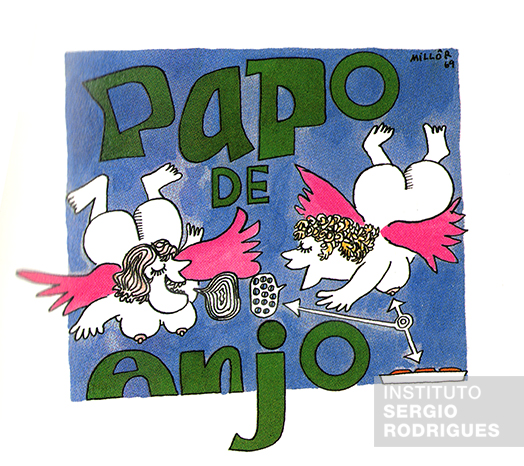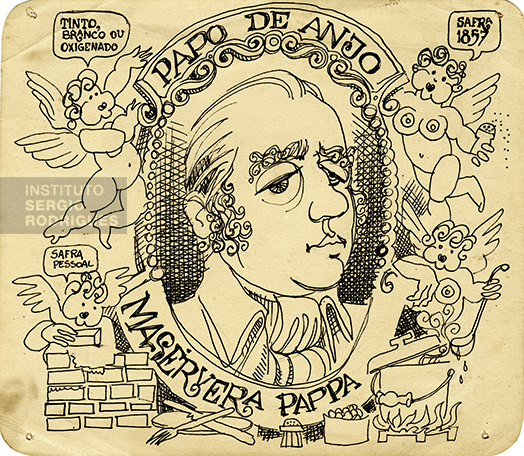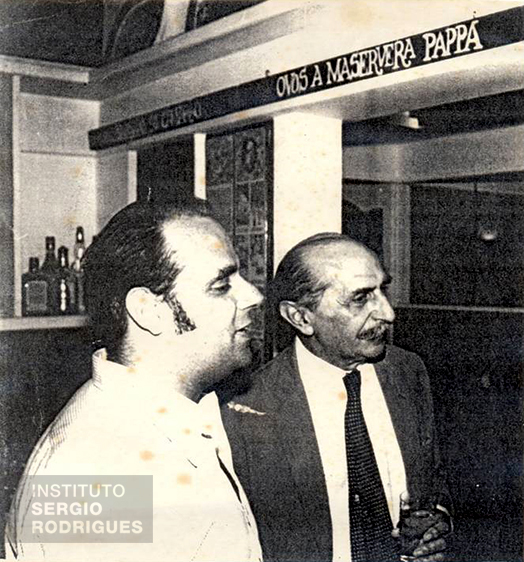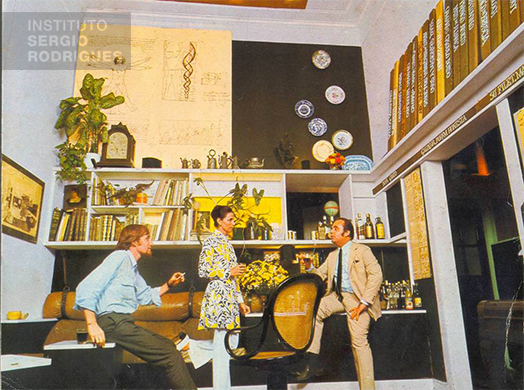Between one business and another, Sergio invented an amazing restaurant
Between one business and another, Sergio invented an amazing restaurant
Sergio never stopped and never gave up, even in adversity. When he left Oca, his situation got worse. Now with four children – Ângela, Veronica, Adriana, and Roberto – Sergio needed to make sure he could support them all. Since he was designing the interior architecture of the Manchete building, which belonged to Bloch Editors, hired by Adolfo Bloch while still at Oca, Sergio decided to continue the work. All of the furniture at Manchete was from Oca, and the contract was with the store, but Sergio did not want to abandon the project and volunteered to complete and supervise it, even if not making any money for his work.
Sergio even made Manchete’s theater, innovating with a wall full of pieces of Jacaranda that were left over from the furniture, an invention later copied by many people. One day, Sergio met Bloch at Manchete. Surprised, Bloch asked:
– Sergio, what are you doing here supervising the work? You are no longer at Oca.
– But this is my responsibility, I have to oversee it, said Sergio.
Adolfo was impressed and decided to sign a separate agreement with Sergio.
– You will be Manchete’s architect.
That was his salvation. For a long time, Sergio worked for Adolfo Bloch’s company. But the arrangement with the owner of Bloch was not enough to solve his life. Since he was restless and could never settle down, he imagined making a lifelong dream come true. Sergio dreamed of finding a restaurant that was not cold, but warm, and where the customer would feel like he was at a friend’s place. Also, talking about eating well was one of his favorite subjects. So why not do both at the same time? In other words, why not realize that dream and the desire to eat a meal in a cozy atmosphere by launching a new venture? His first wife, Vera Maria, cooked very well and it would not be hard, he thought, to get a good place.
They got a house at the Botanical Gardens, on Corcovado street, 252. Franco Magrini, an Italian production engineer who was a good friend of Sergio’s, agreed to work with him at the restaurant. Vera prepared the food, Magrini’s wife made the arrangements. The ceiling was all painted by Juarez Machado, an already well-known artist at that time. There was a lot of sophistication and a bit of everything on the walls: Companhia das Índias ware he was given by his grandmother, important paintings, old plane collections, in short, a fantastic stage design with everything Sergio liked.
Years later, Sergio recounted the restaurant’s adventures: “Thus was created Papo de Anjo, the name I gave it for allowing for a plethora of puns, including Papa de Anjo, Pope of Cooking, Papos, etc. I designed a character, Maservera Pappa, who would be a retired architect, crazy for great food, an expert cook, who would convert his workshop home using its industrial stove in an experimental lab worthy of angels.”
In fact, Maservera Pappa blended the names of Sergio, Magrini, Vera and the word “papa”. Sergio made incredible stories up. There was even a picture of this architect, painted by Magrini. Sergio “mapped out” Maservera’s genealogy tree and handed it over to Millôr Fernandes, who wrote a fun story about the adventures of the architect. The story later became the restaurant’s brochure. The names of the dishes were always deliciously suggestive, like “chicken, but honest”.
“The chosen home […] was a gem. We could call it the “petropolitan” style, very nice. […] Millôr created the logo: the nameplate placed at the entrance was put away every night, because it was so charming that the first ones were stolen at dawn by someone of good taste. Juarez Machado, as a Michelangelo, painted scenes of angels on the dome of the lobby.”
The designer Freddy van Camp, who worked at Oca after Sergio left, when the owner was already the Giulite Coutinho, always admired him a lot. “I like Sergio’s verve, in everything he does. Even in his design. He had a vivid imagination and was always making stories up. At the entrance of Papo de Anjo, there was a wall full of photos. He made up that someone had gone hunting in Africa, a family member, and each photo had a story. He really let his imagination flow. The furniture had a story, often controversial, which changed as his mood did. Sometimes he would tell the story of a piece of furniture one way, sometimes another, different way.”
In the restaurant, the Mole armchair was kept in a place of honor. The restroom bathtub was turned into a huge plant pot. Embassies and all kinds of personalities booked reservations at Papo de Anjo, which was often cited in newspaper and magazine columns. It was also featured in foreign magazines: “When you go to Brazil, you have to go to Papo de Anjo.”
But all architects and friends ate for free. Only foreign champagne and Scotch whiskey was used to cook the food. So, despite its huge success, the restaurant started turning a loss. The partners dropped out and the place was closed.

Folder of the Papo de Anjo restaurant with a drawing by Millôr Fernandes, in 1969, the year it opened.

Illustration by Maservera Pappa, a character Sergio Rodrigues created for his Papo de Anjo restaurant, in Rio de Janeiro, in 1969.

Sergio Rodrigues and Lúcio Costa at the Papo de Anjo restaurant, Rio de Janeiro, in the 1970s.

From left to right, Juarez Machado, Vera Maria Serpa Campos, and Sergio Rodrigues at the Papo de Anjo restaurant, in 1969.
